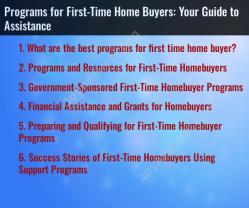What are Fannie Mae guidelines?
Fannie Mae, officially known as the Federal National Mortgage Association (FNMA), is a government-sponsored enterprise (GSE) in the United States. It was created to provide stability and liquidity to the mortgage market. Fannie Mae establishes guidelines and standards for the mortgage industry to ensure the availability of affordable mortgage financing.
Fannie Mae guidelines cover various aspects of mortgage lending, including eligibility criteria, loan limits, underwriting standards, and documentation requirements. Here are some key aspects of Fannie Mae guidelines:
Loan Eligibility Criteria: Fannie Mae sets standards for borrower eligibility, considering factors such as credit history, income, employment stability, and debt-to-income ratio.
Loan Limits: Fannie Mae establishes maximum loan limits, which may vary by location. These limits determine the maximum loan amount that can be purchased or guaranteed by Fannie Mae.
Down Payment Requirements: Fannie Mae guidelines outline the minimum down payment requirements for different types of loans. Down payment percentages may vary based on factors such as the borrower's credit score and the type of mortgage.
Credit Score Requirements: Fannie Mae sets minimum credit score requirements for borrowers. A higher credit score generally leads to more favorable loan terms.
Documentation Standards: Lenders must adhere to Fannie Mae's documentation requirements when processing mortgage applications. This includes verifying income, employment, assets, and other relevant information.
Appraisal Standards: Fannie Mae has guidelines for property appraisals to ensure that the property's value is accurately assessed. Appraisals play a crucial role in determining the loan amount.
Loan-to-Value (LTV) Ratios: Fannie Mae establishes LTV ratios, which represent the percentage of the property's value that can be financed through a mortgage. Lower LTV ratios often result in more favorable terms.
Debt-to-Income (DTI) Ratios: Fannie Mae considers a borrower's DTI ratio, which compares the borrower's monthly debt payments to their gross monthly income. Guidelines specify acceptable DTI limits.
Occupancy Requirements: Fannie Mae guidelines include requirements related to the occupancy of the property. Different guidelines may apply to primary residences, second homes, and investment properties.
It's important for borrowers and lenders to be familiar with Fannie Mae guidelines to ensure compliance and eligibility for Fannie Mae-backed loans. Keep in mind that these guidelines may be subject to updates and changes, so it's advisable to consult with lenders or mortgage professionals for the most current information.
What are the guidelines outlined in Fannie Mae's standards?
Fannie Mae's standards encompass a vast array of guidelines pertaining to various aspects of the mortgage lending process. To give you a focused answer, I need to know which area of interest you have within Fannie Mae's standards. Here are some potential areas:
Loan Eligibility: This covers requirements for borrowers, such as minimum credit score, debt-to-income ratio, and down payment amounts. Different loan programs (e.g., HomeReady®, standard conventional) have different eligibility criteria.
Property Underwriting: This involves guidelines for the property itself, including its type, condition, location, and appraised value. Fannie Mae sets minimum property standards for loans they purchase.
Project Standards: For multifamily properties, Fannie Mae has a separate set of standards concerning the project's financial stability, construction quality, and management practices.
Mortgage Origination and Servicing: These guidelines outline expectations for lenders in processing, closing, and servicing Fannie Mae loans. This includes documentation requirements, due diligence procedures, and customer service standards.
Technology and Reporting: Fannie Mae offers various technology solutions and reporting requirements for lenders to use in originating and servicing loans.
Once you tell me which area interests you, I can provide more specific information about the guidelines involved.













